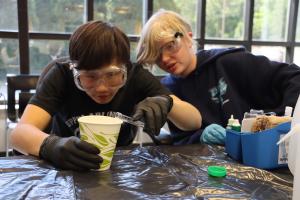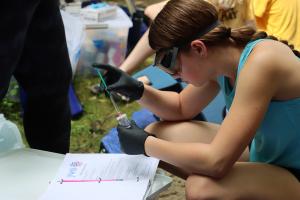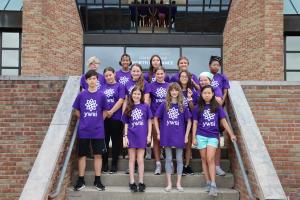This summer middle school students from across the state attended the Ohio Supercomputer Center’s (OSC) Youth Watershed Summer Institute, which offered students the opportunity to collect and analyze data from a local creek, create their own watersheds and learn fundamental computer and analytical skills. The program helped students understand human impacts on biological systems, water chemistry and the importance of habitat to a system’s survival.
Throughout the institute, students also engaged in scientific demonstrations, toured research facilities on The Ohio State University’s campus and enjoyed social activities in the evening.
The program, which OSC hosted as the Young Women’s Summer Institute from 2000 to 2023, underwent changes this year, such as expanding enrollment to students of any gender identity.

“The program now aims to inspire a more diverse group of young scientists by developing their problem-solving, data collection and presentation skills, through working on water quality issues in Ohio’s watersheds,” said Summer Wang, OSC senior client engineer, who helped organize this year’s program.
Paula Williams, the lead teacher for the program, emphasized the number of opportunities for students who attended the Youth Watershed Summer Institute. A significant focus of the camp’s curriculum this year involved analyzing historical data on the changes in the Big Darby Creek watershed and making comparisons to the watershed’s current state. Williams expressed hope that everyone who participated would leave inspired with actionable ideas to help improve Ohio’s freshwater resources.
“This year we have changed the curriculum to really stressing the historic component, where we are present day, and what we can do as citizens to improve our freshwater quality that would impact community members no matter where you live in Ohio,” Williams said.
Data Collection and Projects
At Big Darby Creek, students conducted wildlife observations and assessed the ecosystem, even discovering an endangered species unique to the area, the Tippecanoe Darter fish. They also conducted physical and chemical measures of the creek to gauge pollution levels. After retrieving their data, they compared it to publicly available data, such as research data from the U.S. Environmental Protection Agency (EPA).

“The state of Ohio has dropped probes and monitors in many of our scenic rivers and creeks, and that data is available online. You can see data on the dissolved oxygen in the Big Darby,” Williams explained.
After visiting the creek, students applied their newfound knowledge to group projects focusing on various Ohio watersheds. They formulated hypotheses on specific water quality issues, exploring factors like precipitation and hydromodification’s impact on stream turbidity.
Demonstrations and Tours
Throughout the week, students attended tours and demonstrations to deepen their understanding of watersheds, including daily “impact on science” lectures.
They began with a visit to the Ohio State Aquatic Ecology Lab, where they explored various research methodologies focused on lakes, rivers and marine ecosystems.

Additionally, they actively participated in a watershed demonstration, constructing their own models while learning about the dynamics of watersheds.
At Big Darby Creek, they observed an electrofishing demonstration conducted by the Ohio EPA. The EPA used electrical pulses from a boat to temporarily stun fish, enabling their safe capture for subsequent analysis.
The students also visited Ohio State’s Byrd Polar and Climate Research Center, where they learned about procedures involved in collecting ice cores and rocks on expeditions for research.
On their final tour, the students went to the Chadwick Arboretum and Learning Gardens, where they gained insights into a variety of local vegetation species.
Evening Activities
Evenings were filled with many activities such as game nights, movie screenings and swimming in the recreation center pool. Chaperone Mary Kidwell noted how students enthusiastically participated in these activities and became more comfortable with each other.
“One night they all talked about what movie to watch and played Uno, making sure to ask everyone if they wanted to play,” Kidwell said.

In an end-of-camp survey, one student wrote about how living in the dorms “provided us with some great time to bond, give our brains a small break and make some close friends.”
Another student summarized their overall experience, noting that “I can’t even begin to pick one thing I liked the best. I made so many new friends, met so many cool people, learned so much new vocabulary, had experiences like no other, and some of the best memories I’ve made this summer.”
Overall, the camp provided a balanced mix of education and recreation, allowing students to immerse themselves in learning during the day and enjoy social activities in the evenings.
Written by Kira Ley
Students who are interested in applying for next year’s Youth Watershed Summer Institute can find more information on the OSC website. Ohio residents in the sixth or seventh grades during the application period are eligible to apply for the camp. Applications typically open in January and close in April. Accepted students are notified in May.